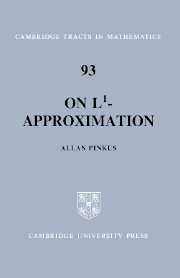Book contents
- Frontmatter
- Contents
- Preface
- 1 Preliminaries
- 2 Approximation from Finite-Dimensional Subspaces of L1
- 3 Approximation from Finite-Dimensional Subspaces in C1(K, μ)
- 4 Unicity Subspaces and Property A
- 5 One-Sided L1-Approximation
- 6 Discrete l1m-Approximation
- 7 Algorithms
- Appendix A T- and WT-Systems
- Appendix B Convexity Cones and L1-Approximation
- References
- Author Index
- Subject Index
5 - One-Sided L1-Approximation
Published online by Cambridge University Press: 06 January 2010
- Frontmatter
- Contents
- Preface
- 1 Preliminaries
- 2 Approximation from Finite-Dimensional Subspaces of L1
- 3 Approximation from Finite-Dimensional Subspaces in C1(K, μ)
- 4 Unicity Subspaces and Property A
- 5 One-Sided L1-Approximation
- 6 Discrete l1m-Approximation
- 7 Algorithms
- Appendix A T- and WT-Systems
- Appendix B Convexity Cones and L1-Approximation
- References
- Author Index
- Subject Index
Summary
Introduction
In the previous three chapters we concerned ourselves with various aspects of the basic problem of best L1-approximation from a finite-dimensional subspace. Some of the topics dealt with were perhaps non-standard, but the setting (i.e., approximation from a finite-dimensional subspace) was a classic one. In this chapter we consider the problem of best one-sided L1-approximation from below, which has been much studied of late. There is an essential difference between these two problems. We are here dealing with approximation from a convex subset of a finite-dimensional subspace which depends on the function being approximated. Moreover the results, i.e., characterization, uniqueness, etc., are different in nature from those of the previous chapters.
To be more precise, let U be a finite-dimensional subspace of C(K). For each f ∈ C(K), we denote by U(f) the convex subset of all u ∈ U satisfying u ≤ f. In Sections 2 and 3 we discuss questions of existence, characterization, and uniqueness in the problem of best approximating f from u(f) in the L1(K, μ)-norm. (We always assume that μ is an ‘admissible’ measure in the sense of Chapter 3.) Somewhat surprisingly, for most ‘reasonable’ U there exist f ∈ C(K) with more than one best approximant (Theorems 5.13 and 5.14).
In Section 4 we ask for exact conditions on the subspace U which imply that there exists a unique best one-sided L1(K, μ) approximant to each f ∈ C(K) from U(f), for a large class of ‘admissible’ μ.
- Type
- Chapter
- Information
- On L1-Approximation , pp. 101 - 131Publisher: Cambridge University PressPrint publication year: 1989

